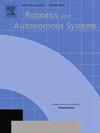An explainable deep learning model for automated classification and localization of microrobots by functionality using ultrasound images
IF 4.3
2区 计算机科学
Q1 AUTOMATION & CONTROL SYSTEMS
引用次数: 0
Abstract
The rapid advancements of untethered microrobots offer exciting opportunities in fields such as targeted drug delivery and minimally invasive surgical procedures. However, several challenges remain, especially in achieving precise localization and classification of microrobots within living organisms using ultrasound (US) imaging. Current US-based detection algorithms often suffer from inaccurate visual feedback, causing positioning errors. This paper presents a novel explainable deep learning model for the localization and classification of eight different types of microrobots using US images. We introduce the Attention-Fused Bottleneck Module (AFBM), which enhances feature extraction and improves the performance of microrobot classification and localization tasks. Our model consistently outperforms baseline models such as YOLOR, YOLOv5-C3HB, YOLOv5-TBH, YOLOv5 m, and YOLOv7. The proposed model achieved mean Average Precision (mAP) of 0.861 and 0.909 at an IoU threshold of 0.95 which is 2% and 1.5% higher than the YOLOv5 m model in training and testing, respectively. Multi-thresh IoU analysis was performed at IoU thresholds of 0.6, 0.75, and 0.95, and demonstrated that the microrobot localization accuracy of our model is superior. A robustness analysis was performed based on high and low frequencies, gain, and speckle in our test data set, and our model demonstrated higher overall accuracy. UsingScore-CAM in our framework enhances interpretability, allowing for transparent insights into the model’s decision-making process. Our work signifies a notable advancement in microrobot classification and detection, with potential applications in real-world scenarios using the newly available USMicroMagset dataset for benchmarking.
利用超声波图像对微型机器人进行功能性自动分类和定位的可解释深度学习模型
无系微型机器人的快速发展为靶向药物输送和微创外科手术等领域提供了令人兴奋的机遇。然而,目前仍存在一些挑战,特别是如何利用超声波(US)成像技术实现微机器人在生物体内的精确定位和分类。目前基于 US 的检测算法往往存在视觉反馈不准确的问题,从而导致定位错误。本文提出了一种新颖的可解释深度学习模型,用于利用 US 图像对八种不同类型的微型机器人进行定位和分类。我们引入了注意力融合瓶颈模块(AFBM),该模块增强了特征提取,提高了微型机器人分类和定位任务的性能。我们的模型始终优于 YOLOR、YOLOv5-C3HB、YOLOv5-TBH、YOLOv5 m 和 YOLOv7 等基线模型。在 IoU 阈值为 0.95 时,拟议模型的平均精度 (mAP) 分别为 0.861 和 0.909,在训练和测试中分别比 YOLOv5 m 模型高出 2% 和 1.5%。在 0.6、0.75 和 0.95 的 IoU 阈值下进行了多阈值 IoU 分析,结果表明我们的模型的微机器人定位精度更高。根据测试数据集中的高频、低频、增益和斑点进行了鲁棒性分析,结果表明我们的模型总体精度更高。在我们的框架中使用 Score-CAM 增强了可解释性,使人们能够透明地了解模型的决策过程。我们的工作标志着在微型机器人分类和检测方面取得了显著进步,并有可能在现实世界的应用场景中使用最新可用的 USMicroMagset 数据集作为基准。
本文章由计算机程序翻译,如有差异,请以英文原文为准。
求助全文
约1分钟内获得全文
求助全文
来源期刊

Robotics and Autonomous Systems
工程技术-机器人学
CiteScore
9.00
自引率
7.00%
发文量
164
审稿时长
4.5 months
期刊介绍:
Robotics and Autonomous Systems will carry articles describing fundamental developments in the field of robotics, with special emphasis on autonomous systems. An important goal of this journal is to extend the state of the art in both symbolic and sensory based robot control and learning in the context of autonomous systems.
Robotics and Autonomous Systems will carry articles on the theoretical, computational and experimental aspects of autonomous systems, or modules of such systems.
 求助内容:
求助内容: 应助结果提醒方式:
应助结果提醒方式:


